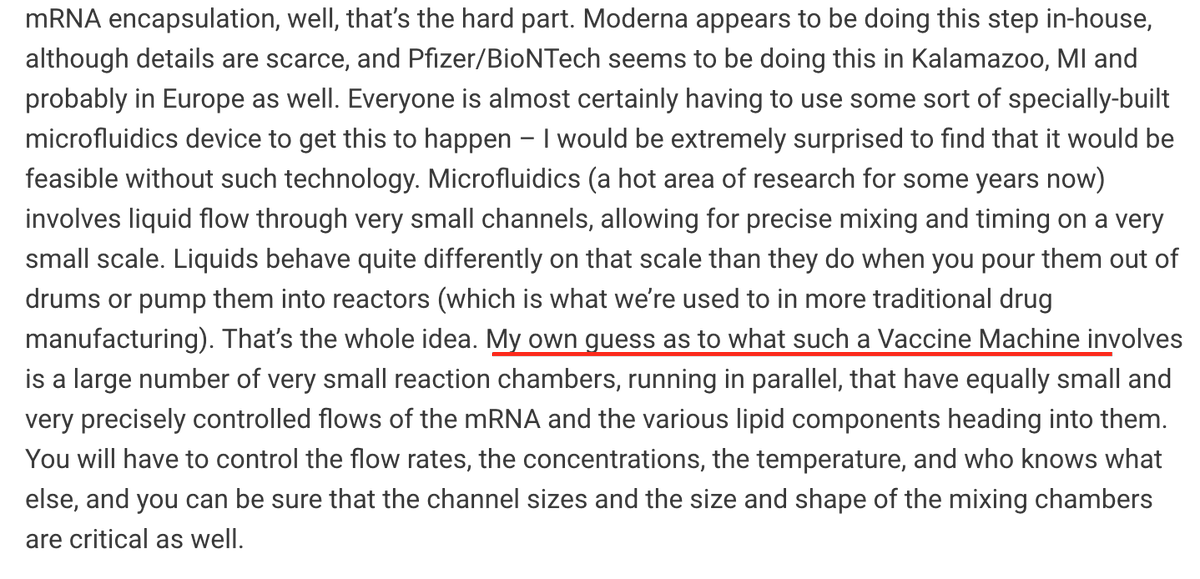This is an accessible primer on the steps involved in, + challenges that need to be overcome in manufacturing mRNA vaccines by @Dereklowe
https://blogs.sciencemag.org/pipeline/archives/2021/02/02/myths-of-vaccine-manufacturing
HT @SarahKarlin
https://blogs.sciencemag.org/pipeline/archives/2021/02/02/myths-of-vaccine-manufacturing
HT @SarahKarlin
As the author notes, converting mRNA + lipids into a well-defined mix of solid nanoparticles is very likely the rate-limiting step.
Very few firms likely have the in-house capacity to accomplish this.
Very few firms likely have the in-house capacity to accomplish this.
But note the underlying problem: The author is only able to guess at how this challenge is overcome.
Why? Because none of these details are known outside the firms using them.
Why? Because none of these details are known outside the firms using them.
And why is that? It's because manufacturing processes are treated as trade secrets, never to be shared.
. @WNicholsonPrice @rai_arti + @TiMinCeBIL have written thoughtfully about this underlying bottleneck of secrecy in @ScienceMagazine https://science.sciencemag.org/content/369/6506/912?rss=1
. @WNicholsonPrice @rai_arti + @TiMinCeBIL have written thoughtfully about this underlying bottleneck of secrecy in @ScienceMagazine https://science.sciencemag.org/content/369/6506/912?rss=1
As they pointed out in August, as many deals with vaccine manufacturers were being signed, overcoming secrecy of manufacturing know-how is crucial scaling up vaccine production
Did any governments even attempt to do so? To make sharing manufacturing know-how a condition of the massive amounts of public money spent on procuring vaccines?
I suspect not.
I suspect not.
And so while it is true that manufacturing capacity is severely limited, unless the underlying knowledge is shared we will never know whether other parties could scale up production or not.
ps. This problem isn't unique to mRNA vaccines. It transcends drug and vaccine industry practices. Take, for instance, the Novavax Covid vaccine candidate that the Canadian govt announced plans to produce domestically just yesterday. https://www.cbc.ca/news/health/novavax-explainer-1.5897946
It includes a 'proprietary' adjuvant called "Matrix-M".
That's "M" for mystery. (Not really).
Some of the details about this adjuvant appear to be in the public domain. See here: https://www.theatlantic.com/science/archive/2020/10/single-tree-species-may-hold-key-coronavirus-vaccine/616792/
That's "M" for mystery. (Not really).
Some of the details about this adjuvant appear to be in the public domain. See here: https://www.theatlantic.com/science/archive/2020/10/single-tree-species-may-hold-key-coronavirus-vaccine/616792/
But lots of other documents, like this June 2020 contract between Novavax + a US consortium, to scale up production, redact the details of Matrix-M.
https://www.sec.gov/Archives/edgar/data/1000694/000155837020013462/nvax-20200930xex10d1.htm
https://www.sec.gov/Archives/edgar/data/1000694/000155837020013462/nvax-20200930xex10d1.htm
I'm happy to be corrected about this particular example; if all the relevant details of Matrix-M are publicly known, lmk.
But secrecy is a pervasive practice when it comes to several aspects of vaccine production + manufacturing.
See, for e.g. https://pubmed.ncbi.nlm.nih.gov/25826194/
But secrecy is a pervasive practice when it comes to several aspects of vaccine production + manufacturing.
See, for e.g. https://pubmed.ncbi.nlm.nih.gov/25826194/

 Read on Twitter
Read on Twitter




